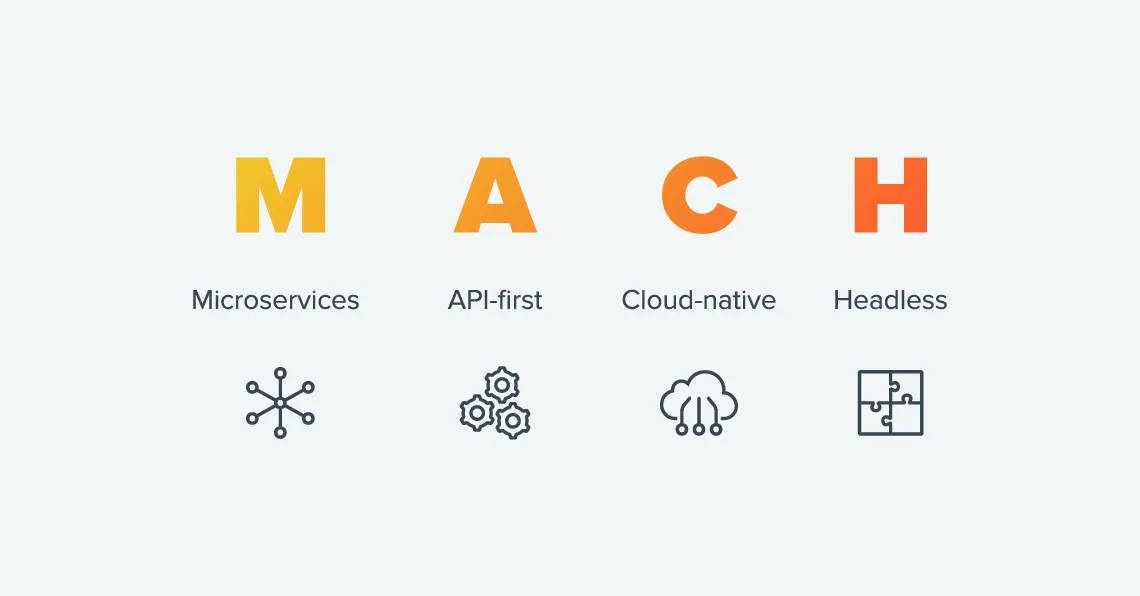MACH and Business Growth: Everything You Need to Know

MACH and Business Growth: Everything You Need to Know
Throughout the modern world, businesses are constantly evolving and transforming as they need to adapt quickly to stay competitive. Traditional monolithic architectures often hinder agility and scalability, making it challenging for businesses to innovate and grow.
This is where MACH architecture comes into play. MACH means Microservices, API-first, Cloud-native, and Headless. This modern approach applies to building digital experiences that are flexible, scalable, and future-proof.
Understanding MACH Architecture
- Microservices: Microservices architecture breaks down applications into smaller, independent services. These vital services can be developed, deployed, and scaled separately. Each service focuses on a specific business function, such as user authentication or payment processing.
- API-first: An API-first approach involves designing and developing APIs before creating the application. This ensures that all services can communicate seamlessly, promoting interoperability and flexibility.
- Cloud-native: Cloud-native applications leverage cloud computing resources, providing scalability, flexibility, and resilience. They can automatically adjust to varying workloads, ensuring consistent performance.
- Headless: Headless architecture decouples the front-end presentation layer from the back-end logic. This allows developers to create flexible and dynamic user interfaces without being constrained by back-end limitations.
How MACH Drives Business Growth
1. Enhanced Flexibility and Agility
So, what is MACH? Well, MACH architecture's modular nature allows businesses to make changes and updates rapidly without disrupting the entire system. For instance, if a company wants to upgrade its payment processing system, it can do so without affecting other services. This key flexibility enables businesses to respond as quickly as possible to market changes and customer demands, fostering innovation and growth.
2. Scalability
With cloud-native applications, businesses can scale their operations effortlessly. During peak times, such as holiday seasons or product launches, MACH-enabled systems can handle increased traffic without compromising performance. This scalability ensures that businesses can grow without being limited by their IT infrastructure.
3. Improved Customer Experience
Headless architecture allows businesses to deliver personalized and engaging user experiences across various channels. By uncoupling the front end from the back end, companies can experiment with different user interfaces and deliver consistent experiences on websites, mobile apps, and even IoT devices. It can lead to higher customer satisfaction and loyalty, driving growth.
4. Cost Efficiency
MACH architecture can significantly reduce operational costs. Cloud-native applications eliminate the need for expensive on-premises hardware and reduce maintenance costs. Moreover, the API-first approach and microservices enable businesses to adopt a pay-as-you-go model, ensuring that they only pay for the resources they use. This crucial cost efficiency is particularly beneficial for startups and small businesses that are looking to scale.
5. Seamless Integration
An API-first approach ensures seamless integration with third-party services and existing systems. Businesses can easily add new functionalities, such as CRM systems, marketing automation tools, or analytics platforms, without extensive rework. This interoperability allows for the creation of a robust ecosystem that supports business growth.
Implementing MACH in Your Business
1. Assess Your Needs
Before transitioning to MACH architecture, conduct a thorough assessment of your business needs and goals. Identify the pain points of your current systems and determine how MACH can address them.
2. Develop a Strategy
Develop a detailed implementation strategy that outlines the steps, timeline, and resources required for the transition. Include risk management and contingency plans to address potential challenges.
3. Choose the Right Partners
Selecting the right technology partners for your needs is crucial for a successful MACH implementation. Look for ones with a proven track record, robust and transparent customer support, and a commitment to continuous innovation.
4. Train Your Team
Ensure that your team is well equipped to work with MACH architecture. Provide training and resources to help them understand the new systems and workflows.
Conclusion
MACH architecture embodies a paradigm shift in how businesses build and deliver digital experiences. Its modular, scalable, and flexible nature provides the foundation for innovation and growth. By adopting MACH principles, businesses can enhance their agility, improve customer experiences, and future-proof their operations.
As the digital landscape continues to transform, embracing MACH architecture will be crucial for businesses that are looking to stay competitive and achieve sustained growth. Investing in MACH today sets the stage for a more resilient, efficient, and prosperous future.